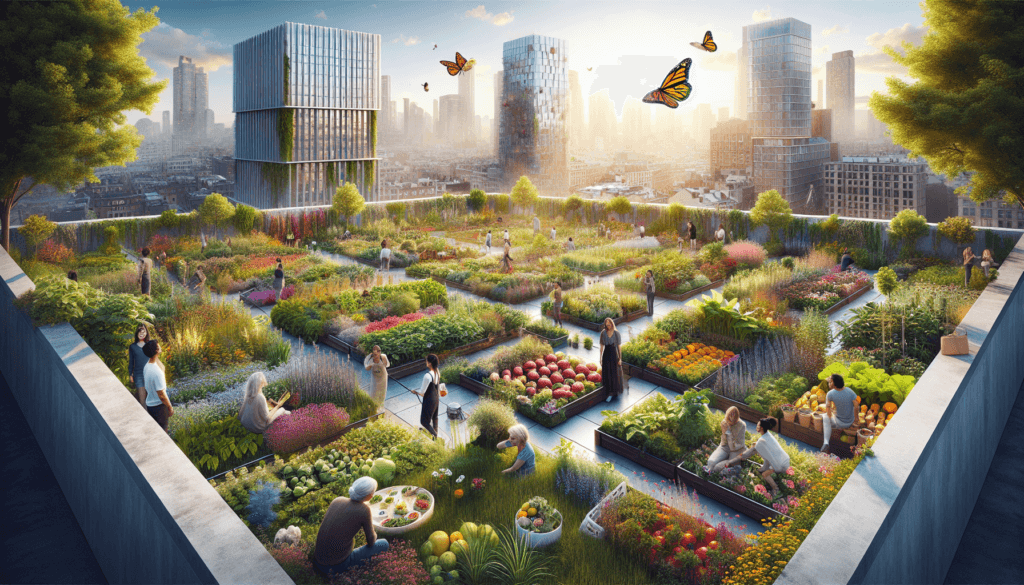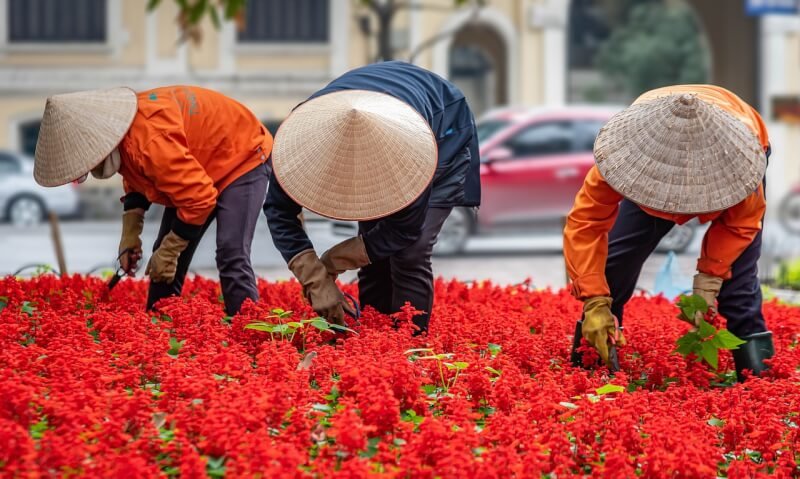If you find yourself amid the hustle and bustle of city life, longing for a peaceful oasis of greenery and tranquility, then look no further. This article is your ultimate guide to creating a therapeutic garden in the heart of the concrete jungle. Discover simple yet effective tips and tricks for urban gardening, bringing nature’s healing touch to your own little haven in the city. From selecting the perfect plants to maximizing limited space, embark on a journey towards serenity and relaxation amidst the chaos of urban living.
Choosing the Right Location
When it comes to creating a therapeutic garden in the city, choosing the right location is crucial. Before you start digging and planting, take the time to consider the available space. Assess the size of your yard or balcony and determine how much space you have to work with. This will help you plan the layout of your garden and ensure that you can accommodate all the elements you want to include.
In addition to space, evaluate the sunlight exposure in your chosen location. Most plants require a certain amount of sunlight to thrive, so it’s important to choose a spot that receives enough natural light throughout the day. Observe your chosen location at different times and determine whether it gets full sun, partial shade, or full shade. This will guide your plant selection and help you create the ideal growing conditions.
Lastly, assess the wind conditions in your chosen location. Strong winds can damage delicate plants and disrupt the overall serenity of your garden. Pay attention to the direction and intensity of the wind in your area, and try to choose a location that is sheltered or has some form of windbreak, such as a fence or tall plants.
Selecting the Right Plants
Now that you have the perfect location, it’s time to select the right plants for your therapeutic garden. Do some research on plant varieties that are well-suited to your climate and growing conditions. Consider factors such as temperature tolerance, water requirements, and overall hardiness. Choosing plants that are suited to your specific environment will increase their chances of thriving and reduce the need for constant maintenance.
It’s also important to consider any space limitations you may have. If you have a small balcony or limited yard space, opt for plants that are compact or can be grown vertically. This will maximize your growing area and create a beautiful and lush garden in a limited space.
When selecting plants for your therapeutic garden, choose low-maintenance varieties whenever possible. These types of plants require less care and attention, allowing you to spend more time enjoying your garden and less time tending to it. Look for plants that are drought-tolerant, disease-resistant, and don’t require frequent pruning or deadheading.

Preparing the Soil
Before you start planting, it’s essential to prepare the soil in your therapeutic garden. Start by testing the soil quality to determine its pH level and nutrient content. You can purchase soil testing kits at garden centers or send a sample to a local agricultural extension office for analysis. Understanding the soil quality will help you determine which amendments are necessary to create an optimal growing environment for your plants.
Based on the soil test results, you may need to amend the soil to improve its structure and fertility. This can involve adding organic matter such as compost, aged manure, or peat moss to enrich the soil and provide essential nutrients. Incorporating organic matter will also enhance the soil’s ability to retain moisture, which is particularly important in urban environments where water may be limited.
Ensure proper drainage in your therapeutic garden by amending the soil with materials such as sand or gravel. This will prevent waterlogging and reduce the risk of root rot. If your garden is situated in an area with poor drainage, you can also consider raising the planting beds or using containers with drainage holes.
Container Gardening
For those with limited space, container gardening is a fantastic option for creating a therapeutic garden in the city. Choose suitable containers based on the size and type of plants you want to grow. Ensure that the containers have adequate drainage holes to allow excess water to escape and prevent waterlogging.
Using a proper potting mix is essential for container gardening success. Avoid using regular garden soil, as it tends to become compacted in containers and restricts root growth. Instead, opt for a high-quality potting mix that is lightweight, well-draining, and rich in organic matter. This will provide the necessary nutrients and ensure optimal root development.
In container gardens, adequate drainage is crucial to prevent waterlogging and root rot. Elevate your containers by placing them on bricks or pot feet to allow excess water to escape freely. This will help maintain the health of your plants and prevent water-related issues.

Vertical Gardening
If space is limited, vertical gardening is a fantastic solution for maximizing your growing area. Utilize vertical space by growing plants up walls, trellises, or other structures. This not only adds visual interest to your therapeutic garden but also allows you to grow a greater variety of plants in a limited area.
Choose climbing plant varieties that are well-suited to vertical gardening. Look for plants that have tendrils, clinging roots, or the ability to twine around supports. Popular options include sweet peas, morning glories, climbing roses, and various types of vining vegetables such as cucumbers and tomatoes.
To create vertical growing structures, install trellises, arbors, or other supports in your garden. These structures provide stability for climbing plants and add an architectural element to your garden design. They can be made from materials such as wood, metal, or even repurposed objects like ladders or pallets. Get creative and choose a design that complements the overall aesthetic of your therapeutic garden.
Watering and Irrigation
Proper watering is essential for the health and well-being of your plants in a therapeutic garden. Establish a watering schedule based on the specific needs of your plants. Some plants may require daily watering, while others may only need to be watered once a week. Pay attention to the moisture requirements of each plant and adjust your watering schedule accordingly.
To conserve water and ensure efficient watering, use techniques such as drip irrigation or a soaker hose. These methods deliver water directly to the root zone of the plants, minimizing water waste and reducing the risk of fungal diseases. Mulch around your plants with organic materials such as straw, wood chips, or compost to help retain moisture and reduce evaporation.
Consider investing in automated irrigation systems to simplify the watering process. These systems can be programmed to water your plants at specific times and for a predetermined duration. This not only saves time but also ensures that your plants receive consistent and adequate moisture, even when you’re busy or away from home.

Managing Pests and Diseases
In any garden, pest and disease management is crucial to maintain the health and vitality of your plants. Implement preventive measures to minimize the risk of infestations. This includes regularly inspecting your plants for signs of pests or diseases, practicing good sanitation, and removing any plant debris or weeds that may attract pests.
When it comes to pest control, opt for organic methods whenever possible. This involves using natural predators, such as ladybugs or praying mantises, to control pest populations. You can also make your own organic insecticides using ingredients like neem oil, garlic, or hot pepper spray. These methods are safer for the environment, as well as for you and your family.
Monitor your plants regularly for signs of diseases such as leaf spots, powdery mildew, or fungal infections. Catching these issues early on allows for prompt treatment and better chances of saving your plants. Remove any infected plant parts, ensure proper air circulation, and consider using organic fungicides if necessary.
Creating a Relaxing Environment
One of the primary goals of a therapeutic garden is to create a relaxing and peaceful atmosphere. Incorporate comfortable seating options in your garden so that you can fully immerse yourself in the tranquil surroundings. Choose outdoor furniture that is both comfortable and weather-resistant, allowing you to enjoy your garden in all seasons.
In addition to seating, add decorative elements that enhance the aesthetics of your therapeutic garden. This can include items such as garden sculptures, decorative pots, or wind chimes. Choose elements that align with your personal taste and create an inviting and visually appealing space.
To further enhance the ambiance, consider incorporating elements that stimulate the senses. Fragrant plants such as lavender, jasmine, or roses can provide a delightful aroma that promotes relaxation. Install gentle wind features such as chimes or rustling ornamental grasses to create a soothing background sound. By engaging multiple senses, you can create a truly immersive and therapeutic experience in your garden.

Implementing Therapeutic Features
To take your therapeutic garden to the next level, consider incorporating specific features that promote relaxation and well-being. Including soothing water features such as a fountain, pond, or birdbath can add a serene and calming element to your garden. The sound of flowing water has been shown to reduce stress and create a sense of tranquility.
Integrate aromatherapy plants into your garden to stimulate the senses and promote relaxation. Lavender, chamomile, and lemon balm are just a few examples of plants known for their calming and stress-relieving properties. You can create a dedicated aromatherapy section in your garden or scatter these plants throughout for a constant sensory experience.
Designate a meditation space within your therapeutic garden where you can practice mindfulness and meditation. This can be as simple as a secluded corner with a meditation cushion or a small platform surrounded by lush vegetation. Creating a designated space for quiet reflection allows you to fully immerse yourself in the therapeutic benefits of your garden.
Maintaining the Garden
To ensure that your therapeutic garden continues to thrive and provide you with its therapeutic benefits, regular maintenance is essential. Schedule regular checks to monitor the health of your plants and identify any issues or pests early on. Pruning plants when necessary can promote healthy growth and prevent overcrowding.
Monitor soil moisture levels regularly, particularly during hot and dry periods. Adjust your watering schedule accordingly to prevent under or overwatering. Remember that different plants have different water requirements, so be mindful of their individual needs.
Inspect the features in your garden, such as seating, decorative elements, or water features, for any signs of wear or damage. Replace or repair any worn-out or damaged elements to maintain the overall aesthetic and functionality of your therapeutic garden.
By following these gardening tips and putting care into creating a therapeutic garden, you can transform even the smallest urban space into a serene and rejuvenating oasis. Whether you have a balcony or small yard, you can enjoy the beauty and tranquility of nature right in the heart of the city. So, roll up your sleeves, dig into the earth, and start creating your very own therapeutic garden today!


